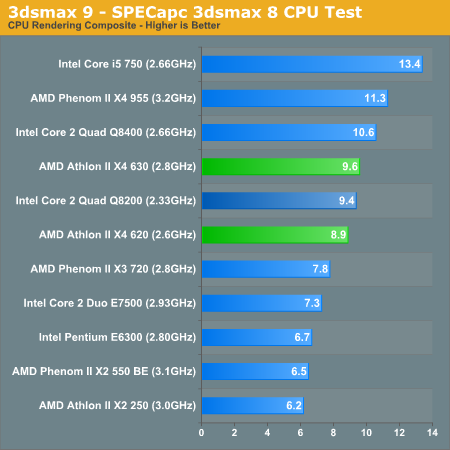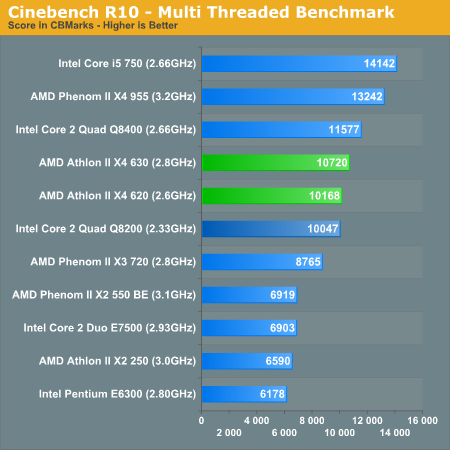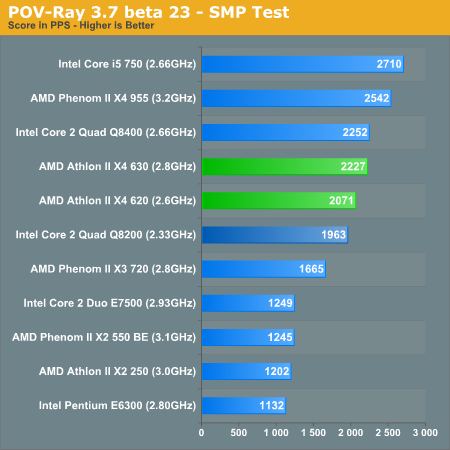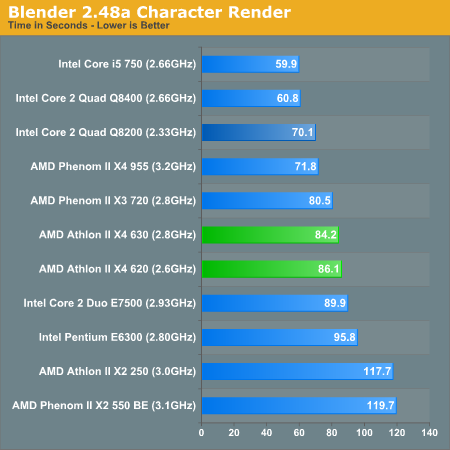AMD Athlon II X4 620 & 630: The First $99 Quad Core CPU
by Anand Lal Shimpi on September 16, 2009 12:00 AM EST- Posted in
- CPUs
3dsmax 9 - SPECapc 3dsmax CPU Rendering Test
Today's desktop processors are more than fast enough to do professional level 3D rendering at home. To look at performance under 3dsmax we ran the SPECapc 3dsmax 8 benchmark (only the CPU rendering tests) under 3dsmax 9 SP1. The results reported are the rendering composite scores:

Offline 3D rendering should be another safe haven for the Athlon II X4. Core count matters and that's what AMD delivers. At $25 per core the Athlon II X4 620 is faster than even the X3 720. It's of course faster than any dual-core CPU in its price range, including the more expensive E7500. Intel's Core 2 Quad Q8200 is around 6% faster but costs 60% more.
Cinebench R10
Created by the Cinema 4D folks we have Cinebench, a popular 3D rendering benchmark that gives us both single and multi-threaded 3D rendering results.

Single threaded performance is where the Athlon II X4 suffers the most. It's competitive but still slower than cheaper dual-core CPUs. This is the classic trade off for all pre-Lynnfield quad-core CPUs, you give up single threaded performance for multi-threaded performance. Luckily for AMD, Intel's Core 2 Quads suffer the same fate. While the Athlon IIs find themselves at the bottom of this chart, the Q8200 is the slowest chip here.

Turn up the thread count and the Athlon II shines once more. Again, the 620 is about the same speed as the Q8200, but slower than the Q8400. Just where it needs to be.
POV-Ray 3.73 beta 23 Ray Tracing Performance
POV-Ray is a popular, open-source raytracing application that also doubles as a great tool to measure CPU floating point performance.
I ran the SMP benchmark in beta 23 of POV-Ray 3.73. The numbers reported are the final score in pixels per second.

At this point I couldn't write a more competitive position for AMD. The Athlon II X4 continues to do very well in our 3D rendering tests.
Blender 2.48a
Blender is an open source 3D modeling application. Our benchmark here simply times how long it takes to render a character that comes with the application.

Our Blender test has traditionally favored Intel architectures, and here we see the first signs of the Athlon II X4 not being able to keep up. The Phenom II X3 720 and Core 2 Quad Q8200 are both faster, but compared to Intel's similarly priced dual-core offerings AMD is still quicker.










150 Comments
View All Comments
The0ne - Wednesday, September 16, 2009 - link
Whether you like to believe it or not, crippling or, in a nicer way, not release some of the features is pretty common in both software and hardware environments. Whether the decision was due to money, managerial ignorance, or a time-line it is still a feature that is not in the product that could be there.If you consider putting all features, which is impossible btw, then you run into issues where the consumer or market doesn't even need them. We have USBs, wireless, biometric security available in one of our product but 95% of the market could care less. They are still on serial lines and are uneducated on newer technologies. Most city halls are like this that is why you see plain old switching voting systems still in place and the occasional typewriter.
The0ne - Wednesday, September 16, 2009 - link
You mean like the I5?andrenb91 - Wednesday, September 16, 2009 - link
it's just a cpu...I'll buy it when I need it, my amd athlon 4850e and intel pentium dual-core e5200 still good enoughMrCommunistGen - Wednesday, September 16, 2009 - link
Anyone know where you can get these? If not yet available, then when? I have a friend who needs a new computer, and the AII X4 620 would be a pretty good fit for him. I was somewhat grudgingly recommending the Ph II X2 550, but the X4 620 seems to offer much more balanced performance.pervisanathema - Wednesday, September 16, 2009 - link
These results are meaningless. The intel CPUs should be forced to run 24x7 at their highest possible turbo speed. To do otherwise let's AMD lose by a smaller margin.i'm going to stay here saying the same until hell freezes.
i'm not going to accept under clocked results presented as if they were stock results.
this is a casus belli.
i mean it.
fitten - Wednesday, September 16, 2009 - link
Heh... I see what you did there ;) I'm with you!johnsonx - Wednesday, September 16, 2009 - link
lolClownPuncher - Wednesday, September 16, 2009 - link
I see what you did there! Nice jobExar3342 - Wednesday, September 16, 2009 - link
For $50 more, you get a much more energy efficient and faster processor. I would only recommend this quad to those with a MB that supports it, they need an upgrade, and they don't have much cash.AMD can't be making much money off these processors...
bji - Wednesday, September 16, 2009 - link
"For $50 more" means "for 50% more" in this case. It's kind of ridiculous to talk about the difference of $50 in this context as if it's trivial. Those costs are not remotely comparable, so the implication that you might as well just spend $50 more to get the faster/more efficient processor is not justified by your statements.I personally always do target $150 for a processor price when building a new system - this is a habit I got into with my very first build, using a Pentium 100 which at the time cost $150. This means that a $200 processor which has better performance is not even in the realm of consideration for me, even though it is "only $50 more", which in this case, is an even smaller percentage increase than in the case you are talking about.
Just in case I haven't made my point abundantly clear: you can't recommend spending $50 more for someone who has budgeted $100 for the processor. You have to compare similarly priced CPUs. I would like to see more comparisons with the Phenom II 550 BE for that reason.